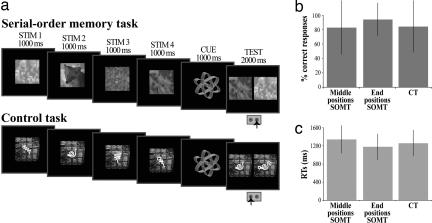Fig. 1.
Behavioral tasks and performance. (a) In both the SOMT and the CT, four new abstract nonverbal black and white stimuli were presented successively for 1,000 ms each. The presentation of the sequence was followed by a cue (1,000 ms) and then the test period (2,000 ms). A random delay varying from 2.5 to 7.5 s (average = 3.5 s) was interspersed between the presentation of each one of the four stimuli, the cue, and the test period to enable the signal for each of these events to be measured. In the test period of the SOMT, two of the four stimuli from the preceding sequence were shown, and the subject had to indicate which one occurred earlier in the sequence. In the test period of the CT, one of the four stimuli from the preceding sequence and a new stimulus were shown, and the subject had to indicate the stimulus presented in the preceding sequence. Note that four new stimuli were used during the sequence presentation in all trials. (b) The subjects' mean (±SD) percent correct responses during the test period for judgments involving stimuli presented in the middle and end positions in the SOMT and all positions in the CT. Performance was significantly higher for the end positions in SOMT than for judgments involving the middle positions in SOMT and all positions in the CT (see Behavioral Performance During Scanning). (c) The subjects' mean (±SD) reaction times in the correct trials for judgments involving stimuli in the middle and end positions in SOMT and all positions in CT. Note that the mean reaction time for judgments involving the end positions in SOMT was significantly lower than for judgments involving the middle positions in SOMT and the CT (see Behavioral Performance During Scanning).

